Bradford City Tramways
History
Bradford Corporation became a tramway owner, though not an operator, on the 2nd February 1882, when horse-drawn services commenced along its newly built, 4 ft-gauge line along Manningham Lane.
The corporation was keen to retain control of any tramway development within the town, and by 1880 had already seen off two attempts by promoters to build tramways; it then obtained powers to build the first three lines of its own system, these being granted in 1881. Although the corporation was permitted to build and own tramways, the Tramways Act of 1870 forbade local authorities from operating them, except in the unlikely event that a lessee could not be found, as was later to be the case at nearby Huddersfield. Operation of the new lines was therefore formally leased to the Bradford Tramways Company (for a period of 21 years), this company having been expressly formed to operate the tramway. Construction of the first line along Manningham Lane commenced on the 8th September 1881, an official party being transported over the new line on the 1st February 1882, which was then opened to the public the following day. The lessee company was formally reconstituted as the Bradford Tramways and Omnibus Company Limited just two days later on the 4th September 1882.
The remaining two authorised lines — along Leeds Road and Sunbridge Road — quickly followed, opening on the 7th June and the 25the September, respectively. Although these lines initially used horse traction, only Manningham Lane was suited to it, being just about the only flat stretch of road in the entire town, the other routes switching to steam traction just as soon as sufficient engines arrived, this taking place on the 2nd August and the 27th September 1882, respectively.
Further powers were obtained in 1883, which included a line along Manchester Road to Bankfoot. The corporation naturally assumed that the BT&OCo would take on the lease, but instead it declined, being either unwilling or unable to do so. Instead, the lease went to a new company, the Bradford and Shelf Tramways Company, the line opening on the 8th September 1884, and being steam operated from the outset. The failure to agree terms with the BT&OCo for this lease seems, however, not to have impacted relations between the corporation and the company, as new lines — built under powers granted in 1883, 1886, 1887 and 1890 — continued to be leased to the BT&OCo. These included: an extension of the Manningham Lane line to Frizinghall (opened on the 26th January 1885); new lines to Allerton (opened on the 19th November 1887), Undercliffe (opened on the 10th October 1888) and Tong (opened in sections between the 6th April 1893 and the 2nd March 1894); and an extension of the Leeds Road line to Thornbury (opened in October 1888). With the exception of the Manningham Lane extension, all these new lines were operated by steam traction.
When the government lifted the prohibition on local authorities operating tramways in 1896, Bradford lost no time in developing plans for its own municipal tramway, obtaining powers for its initial two lines on the 29th March 1897. The town was expanding rapidly, becoming a city on the 9th June 1897, and opening a large electricity generating plant the following October. Instead of converting the existing tramways to electric traction, the corporation instead decided to construct new lines, before tackling the tricky issue of the leases, which all ran to February 1903. Construction of the first line commenced in January 1898, the first services commencing on the 30th July 1898 under the name of Bradford City Tramways.
The new electric services were an immediate success, such that further powers were obtained and more lines built, including electrically operated extensions to the steam tramway lines, passengers having to change from one form of traction to the other. With regard to the leased lines, the corporation had a simple choice, either to let the leases run their full course to February 1903 or terminate them earlier, the latter option requiring compensation to be paid. The corporation's desire to press on with its grand scheme, and thereby realise the benefits of a fully integrated system sooner rather than later, led it to terminate both the BT&OCo's and the B&STCo's leases on the 31st January 1902. The corporation duly took over operation of all the horse and steam lines the following day, using engines and trailers leased from the companies, all the operating staff having become employees of the corporation.
Conversion to electric traction proceeded apace, the Thornbury route switching over to electric operation barely four weeks after the municipal takeover on the 27th February 1902. The last of the old horse and steam lines was switched over to electric traction on the 2nd September 1903, the last horse car having run on the 16th May 1902, and the last steam service on the 1st April 1903. Further expansion took place during the mid-Edwardian era, including the takeover of Shipley Urban District Council's tramways on the 30th April 1904, the previously lessee — the Mid-Yorkshire Tramways Company — having run into severe financial difficulties.
The last significant extension, to Crossflatts, opened on the 13th October 1914, taking the system to its greatest extent, 59 miles, circa 46 miles of which were in Bradford, the rest being in the territories of neighbouring authorities. Lines radiated out from the city centre: northeastwards to Thackley, Idle, Eccleshill and Greengates; eastwards to Thornbury and Stanningley; southeastwards to Drighlington and Birkenshaw; southwards to Bailiff Bridge; southwestwards to Shelf, Wibsey, and Queensbury; westwards to Lidget Green and Thornton; northwestwards to Allerton, Duckworth Lane and Heaton; and northwards to Saltaire, Bingley, Crossflatts, Shipley and Baildon Bridge. The tramway met the Halifax Corporation Tramways system at Bailiff Bridge, Shelf and Queensbury, though the tracks were not connected, as the HCT system was built to a gauge of 3ft 6ins. Likewise, at Birkenshaw, where the tramway met the standard-gauge tracks of the Yorkshire (Woollen District) Electric Tramways Company. At Stanningley however, where the system met the tracks of the standard-gauge Leeds City Tramways, a connection was made, services operating between the two cities (from 22nd April 1907 to the 31st March 1918) using specially designed tramcars with extensible axles.
Like most other systems around the country, during the Great War the system suffered from loss of men (and their skills) to the armed services, severe shortages of spares, and stringent government restrictions on the purchase of new material such as track. As a result, the system emerged from the conflict in run-down condition, with circa 50% of the tramcar fleet being out of action, and a corresponding impact on services. Although the corporation spent considerable sums on repairing the track and restarting its pre-war tramcar rebuilding programme, as well as buying new vehicles, the advent of a new manager, who was an enthusiastic adherent of 'trackless trams' (trolleybuses), was ultimately to change the dynamic.
Whilst the corporation had in fact operated trolleybuses since the 20th June 1911, viewing them as a low-cost alternative for routes beyond the tramway system, their use had always been on a fairly small scale. During the1920s, however, the new manager's thoughts quickly progressed from adding new 'trackless' routes (to complement the tramway system), to replacing the trams altogether as the tracks came up for renewal. His enthusiasm for the new generation of trolleybuses was, however ,not shared by the general populace (nor many of the councillors), such that his proposal to replace the Idle and Thackley trams with trolleybuses had to be hurriedly dropped and the tracks repaired. It was in fact to be the end of the decade before a tram line would be replaced by trolleybuses, the last tram to Allerton running on the 30th November 1929, and the disputed Thackley route early the following year.
In 1925, independent motorbus competition started to make serious inroads, the corporation being especially irritated by the actions of the West Riding Automobile Company. The corporation fought back, acquiring powers in 1925 to run motorbuses within the municipal boundary — the first service commencing on the 13th May 1926 — services being steadily expanded, including to destinations outside the municipal boundary, powers for which were obtained in 1928. The first tramway closure facilitated by motorbuses took place on the 11th November 1928, though the motorbuses were in fact a temporary expedient pending the arrival of new trolleybuses; the first tramway replacement proper did not take place until the 10th August 1933.
Tramway abandonments continued throughout the 1930s, the corporation having obtained powers to completely abandon the system in 1930, some succumbing to trolleybuses and some to motorbuses. The change in the predominant mode of traction was reflected in the name, the Tramways Committee deciding on the 15th July 1935 that the undertaking would henceforth be known as Bradford Corporation Passenger Transport. By 1939, most of the network north of the city centre had gone, but with the outbreak of war, replacement had to be put on the back burner, many of the tram lines, which had had as little money spent on them as possible, having to be patched up in order to keep some level of service running. The Stanningley route was in particularly bad condition, the last tram running on the 19th October 1942, being replaced by ancient second-hand buses from London. After the war, with trolley and motorbuses difficult to get hold of, and new vehicles first having to replace existing worn-out vehicles, the corporation could not proceed as quickly as it would have liked with the tramway abandonment. As a result, the by-now decrepit trams had to soldier on for a few more years, the last tram of all finally running on the 6th May 1950, bringing this once extensive system to a close.
The tramways were very profitable, making enough money to not only subsidise loss-making trolley and motorbus services, but also to make sizeable contributions to the corporation rates. All this was achieved whilst building up significant renewals and reserve funds, which were then raided by other council departments (in the 1920s). This meant that expansive track renewals could no longer be paid for without borrowing, a situation which inevitably contributed to decisions to adopt 'cheaper' transport options, i.e., the trolleybus and the motorbus.
Uniforms
Bradford Corporation operated horse and steam services, which it had taken over from the BT&OCo and the B&STCo, for approximately three and thirteen months, respectively. Photographs which unequivocally date from this period, and which show staff appear not to have survived, so it is currently not possible to say what uniforms, if any, these men would have worn.
Photographs of the very earliest years of the electric tramway era show staff wearing double-breasted uniform jackets with five pairs of buttons (presumably of the boar's head variety) and lapels; the latter do not appear to have carried any badges. The peaked caps were soft-topped, and carried script-lettering grade badges — either 'Driver' or 'Conductor' — these almost certainly being brass to match the buttons.
Around the turn of the century, or possibly shortly thereafter, the style of the uniform was completely changed. Staff were now issued with double-breasted, lancer-style tunics with five pairs of buttons (narrowing from top to bottom) and stand-up collars. The bearer's left-hand collar carried a staff number (in brass numerals), whilst the right-hand collar carried a small badge, again brass, almost certainly a municipal device of some description. Smart drooping-peak caps were also introduced, which for a time do not appear to have borne a cap badge, or at least one that showed up during photography. By around 1903, however, the caps bore a large voided (i.e., open backed) cap badge with ‘B C T’ system initials at the top and the grade along the bottom ('DRIVER', 'CONDUCTOR' and 'PARCELS' are known); in the case of motormen and conductors, a class was carried in the centre ('DRIVER CLASS 1' and 'CLASS 3' have survived, as well as 'CONDUCTOR CLASS 3').
Some time prior to 1907, when the City of Bradford was officially granted ‘ram and goat’ supporters to its coat of arms, the drooping-peak caps were dispensed with in favour of peaked caps with tensioned crowns (tops); these continued to bear the same large voided badges as the previous caps. Photographs taken from around 1908 onwards, however, clearly show that the Tramways Department reacted swiftly to the grant of supporters, issuing new cap and collar badges. The cap badges (see below) were produced in brass and blue enamel; they contained the full tramway title above the new coat of arms, with a voided, lozenge-shaped surround below containing an employee number. Although the style of the tunics remained the same, the old collar designations were replaced by a new municipal-device badge (worn on both collars; see below). The heraldic device on the tramcars was also changed around this time.
One of the studio portraits shown below clearly shows the subject wearing the new ‘coat of arms’ cap badge along with the older unmarked ‘boars head’ buttons; presumably, the corporation waited until uniforms were in need of replacement before issuing new ones. Later photographs (see below) show that the tunics were subsequently changed to a single-breasted design, though still with stand-up collars; the latter continued to bear the municipal-device badge.
The lancer-style tunics were superseded by a single-breasted design with stand-up collars and two button-closed breast pockets; the insignia, however, remained the same.
Around the 1930s or 1940s, the jackets were changed to a more modern design, which though still single-breasted (with four buttons), now had wide lapels; the collars continued to bear the same municipal-device badges as the previous jackets. It is likely that a switch was made to chrome buttons and badges around this time, as titled 'tramway' cap badges have survived in this material.
Photographs of senior staff are rare — the 1898 depot photo below includes a single inspector, who is wearing a single-breasted jacket with lapels, braided epaulettes and cuff embellishments; headgear took the form of a drooping-peak cap, which appears to have carried the grade — 'Inspector' — in embroidered script lettering, and the system initials — 'B C T' — above. By 1902, however, a more traditional style of inspector's uniform appears to have been adopted, still single-breasted, but with hidden buttons (or more likely a hook and eye affair), edged in material of a finer quality than the main body, and with stand-up collars. Although the insignia cannot be made out on surviving photographs, in all probability, both collars bore the grade — 'Inspector' — in embroidered script lettering. In the early-Edwardian period, inspectors were also issued with long, double-breasted overcoats with lapels; the collars, like the jackets worn underneath, bore embroidered badges, probably the bearer's grade.
By the time of the Great War, inspectors were wearing tensioned-crown peaked caps; these carried a prominent brass badge inlaid with red and blue enamel, comprising the arms of Bradford with the motto and grade ('INSPECTOR') in ribbons beneath, inlaid with blue enamel. It is unclear exactly when this badge was introduced, though in all probability, it was in or shortly after 1907, following the official grant or arms to Bradford. Although this badge was probably used right through to the closure of the system in 1950, there remains a possibility that it was superseded by a new chrome badge comprising 'BCT' initials with the arms or Bradford above and the grade in a bar beneath, inlaid with blue enamel (see below).
Women were employed in considerable numbers during the Great War to replace conductors lost to the armed services; they were issued with long skirts and tailored, single-breasted jackets with five buttons, four pockets (with button closures), a waist belt (with button closure) and lapels. The bearer's left-hand collar bore a one-piece metal scroll badge comprising the system initials , 'BCT' – the right-hand collar bore a municipal-device badge along with an employee number, both probably brass. Two types of headwear were provided, presumably for winter and summer wear respectively, namely: a felt bonnet bearing a hat band with the grade — 'CONDUCTOR' — rendered in embroidered block capitals; and a shiny, dark-coloured waterproof bonnet, which appears not to have carried a badge.
Conductresses were also taken on in the Second World War, the first of them starting on the 31st March 1941, and the last of them leaving in August 1946; details of the uniforms worn remain, however, unknown.
Further reading
For a history of Bradford's tramways, see: 'Bradford Corporation Tramways' by J S King; Venture Publications (1999).
Images
Motormen and conductors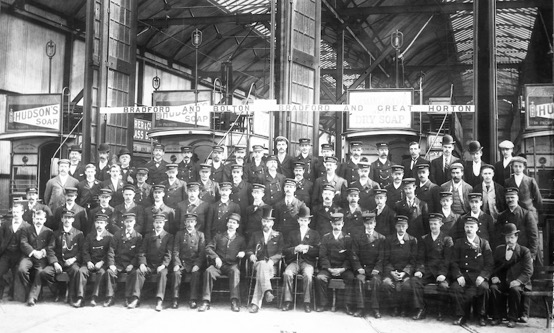
A Bradford City Tramways staff photograph taken at Bolton Road depot in 1898, almost certainly to commemorate the inauguration of municipally operated services. Photo courtesy of the National Tramway Museum.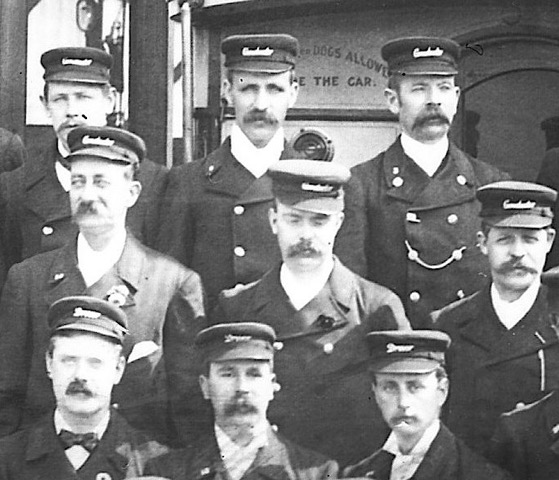
An enlargement of the above photograph, clearly showing the soft-topped peaked caps, which bear 'Conductor' and 'Driver' script-lettering grade badges. The jackets appear to be devoid of insignia, and curiously, many also appear to be several buttons short!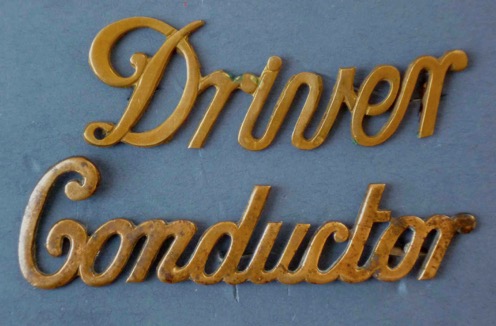
General pattern script-lettering cap badges of the type used by Bradford City Tramways — brass. These badges were used from 1898 to around 1900. Author's Collection.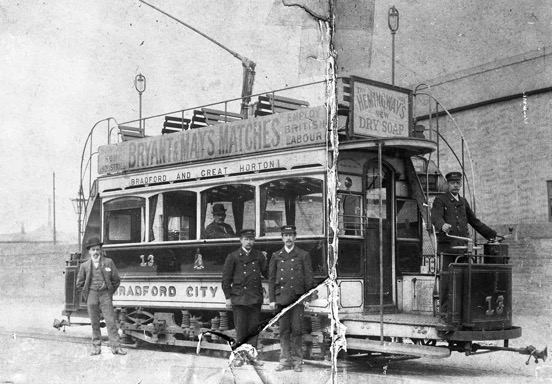
A group of men pose with Tramcar No 13 outside what is probably Horton Bank Top depot — photo undated, but almost certainly taken in late 1898. Photo courtesy of the National Tramway Museum.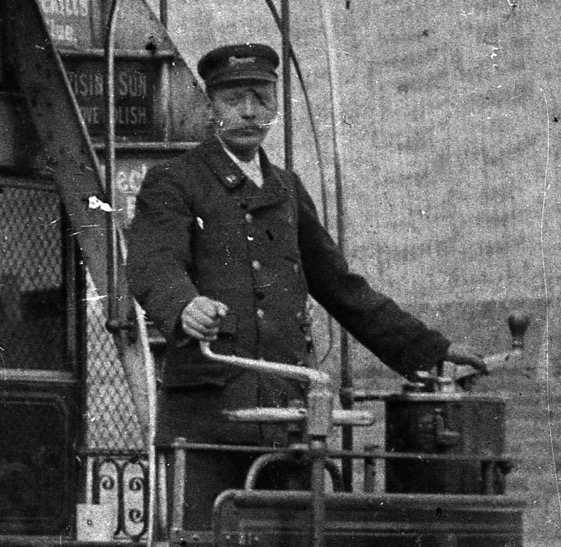
An enlargement of the above photograph showing the motorman, who may be wearing a badge on his collar, though this is far from certain. 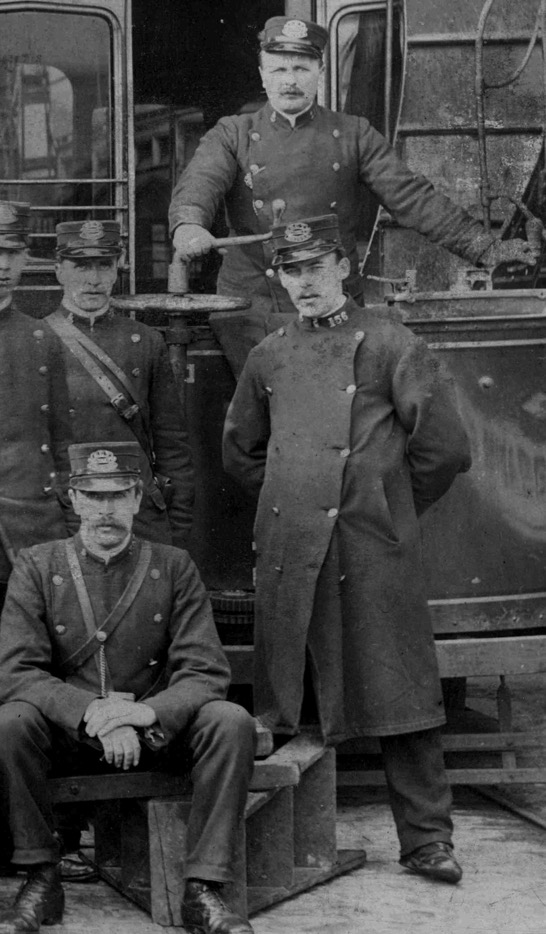
A group of conductors and motormen (known as drivers in Bradford) taken in 1904. By this time, the uniform jackets and greatcoats had been changed to a lancer style with stand-up collars. The collar designations, kepi caps and second style of cap badge are easily discerned. With thanks to the late Stanley King.
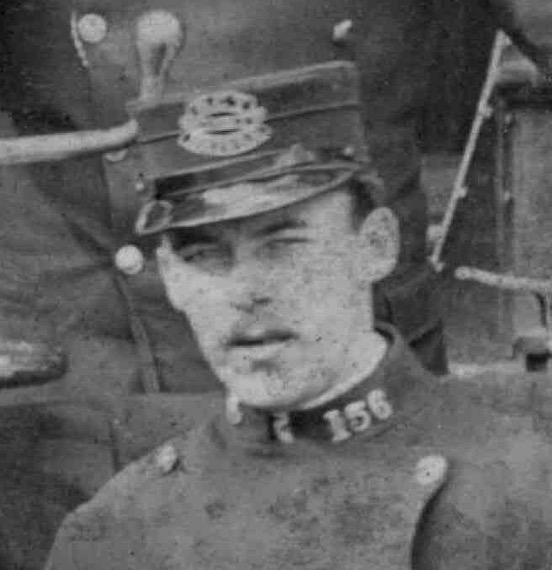
An enlargement of the above photograph showing Driver No 156; the voided (i.e. open backed) cap badge consists of 'B. C. T.' initials (at the top) and the grade, 'DRIVER' along the bottom. The text in the centre cannot be made out, but will be the class of driver e.g., 'CLASS 1'. The right-hand collar in this photograph appears to bear a coat of arms type badge.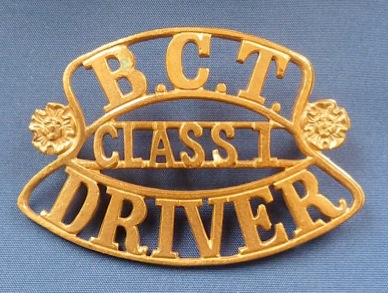
Bradford City Tramways 'CLASS 1 DRIVER' cap badge — brass. This style of badge was used from circa 1900 to 1907. Author's Collection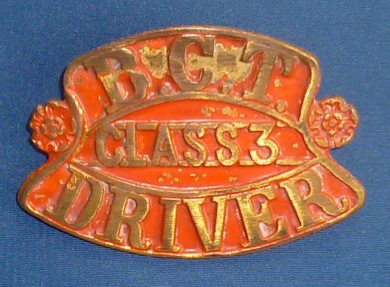
Bradford City Tramways 'CLASS 3 DRIVER' cap badge — brass. It is unclear whether this is an unfinished example or whether some badges were also issued in this non-voided form. Author's Collection.
Bradford City Tramways 'CLASS 3 CONDUCTOR' cap badge — brass. It is unclear whether this is an unfinished example or whether some badges were also issued in this non-voided form. Author's Collection.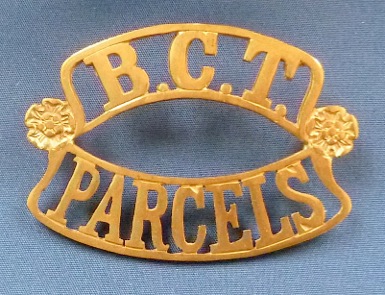
Bradford City Tramways 'PARCELS' cap badge — brass. The Tramways Parcels Service commenced on the 1st January 1905, so this badge would presumably have been used between that date and 1907. Author's Collection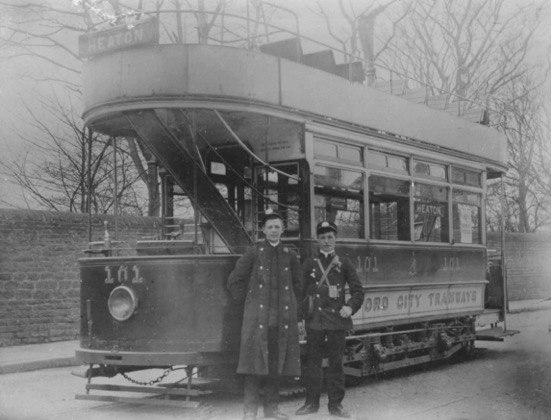
A motorman and a conductor stand with Tramcar No 101 at what is probably the terminus at Heaton — photo undated, but definitely taken between 1902, when this vehicle was new, and 1904, when it was top-covered. Author's Collection. 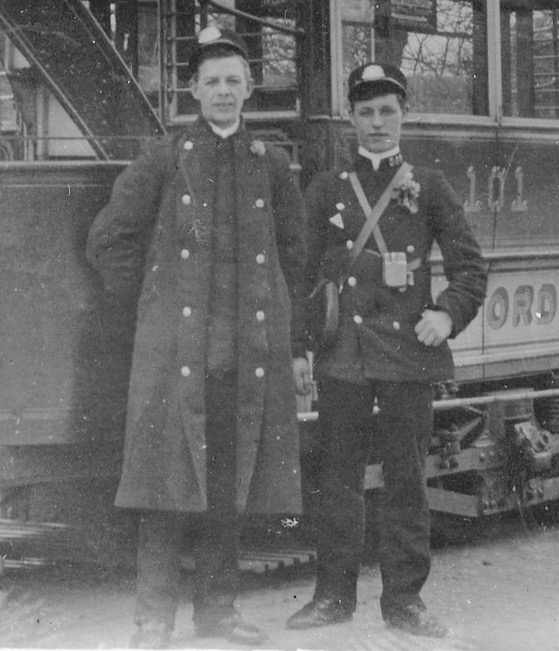
An enlargement of the above photograph showing the tramcar crew, both of them wearing kepi-style hats with the new pattern of cap badge, as well as flowers, so it was clearly a special occasion. Author's Collection. 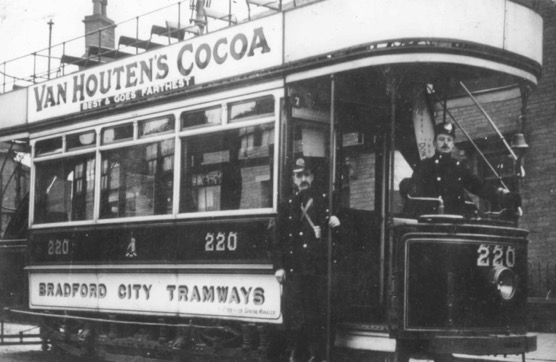
A conductor and a motorman aboard Tramcar No 220 — photo undated, but given the excellent condition of the vehicle, probably taken in 1903 or 1904. Both men are wearing lancer-style greatcoats and kepi-style caps. Author's Collection.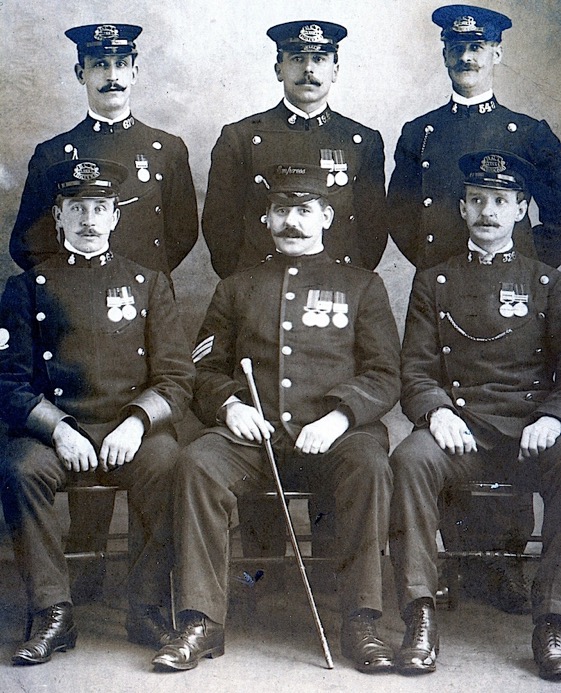
A group of Bradford City Tramways employees wearing tensioned-crown peaked caps, but still with voided cap badges — photo undated, but probably taken between 1905 and 1908. Clockwise from top left: Employee 610 ('CONDUCTOR'); 194 ('DRIVER'); 548 ('CONDUCTOR'); 326 ('CLASS 1 CONDUCTOR'); Herbert Rowe (a BCT conductor, but seemingly in military uniform with a cap that may be from the Empress Theatre in Bradford); and 269 ('CLASS 1 DRIVER'). There are a mix of Boer War and India medals on show, the most recent of which, the Kings South Africa Medal dates to 1902; allowing for production and distribution, this suggests a date for the photograph of 1904 (my thanks to Alan Cook for this information). With thanks to Ian C Henry, Herbert Rowe's great nephew.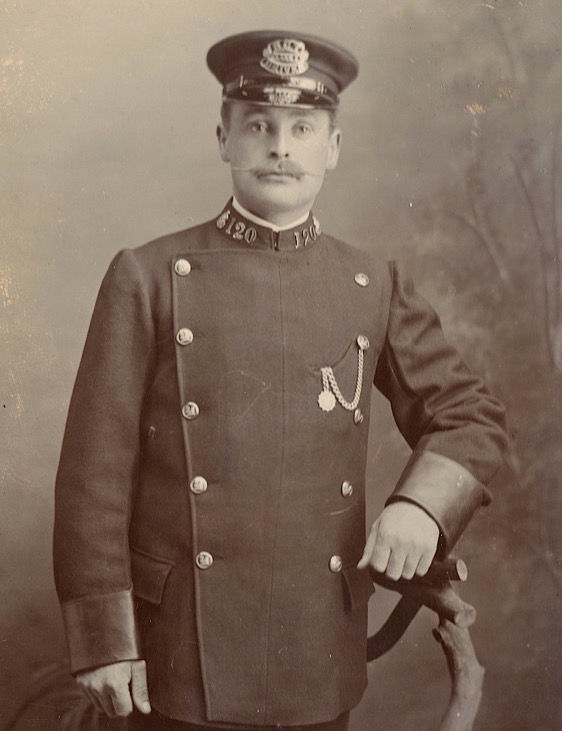
A studio portrait of a Bradford City Tramways motorman (Employee No 120) — photo undated, but probably taken between 1905 and 1908. The subject has the newer style of tensioned-crown peaked cap, but with a voided cap badge. His collars have the employee number on both sides rather than just the bearer's left-hand side. Author's Collection.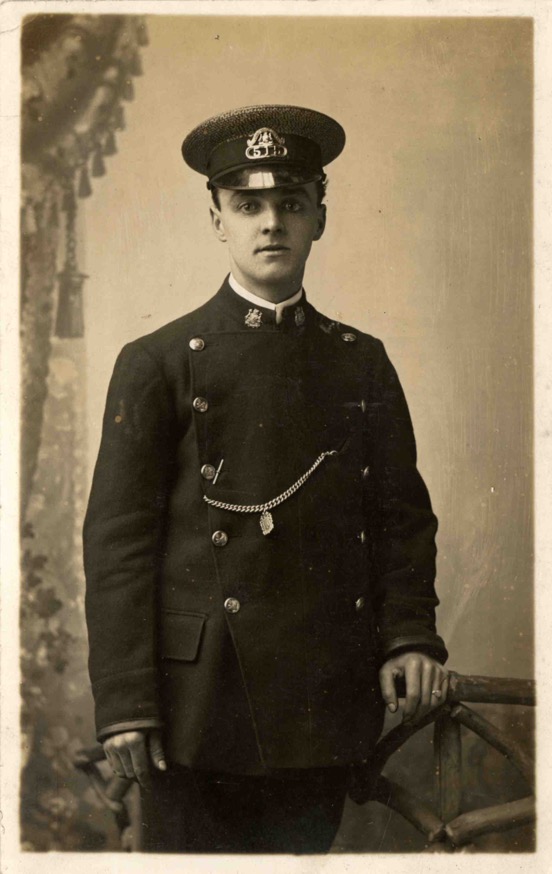
BCT Employee 515 — probably taken soon after 1907 when Bradford was granted 'ram and goat' supporters to its arms. Note the new municipal cap and collar badges (with the new supporters); the buttons are, however, still the older ‘boars head’ pattern. Author's Collection.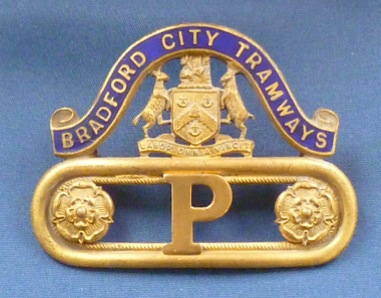
Bradford City Tramways cap badge — circa 1907/8 onwards — brass. The 'P' probably refers to the Tramways Parcels Service. Author's Collection.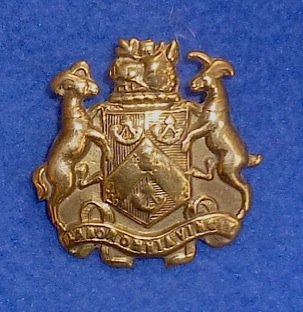
Collar/lapel badge — brass (worn from 1907/8 onwards). Author's Collection.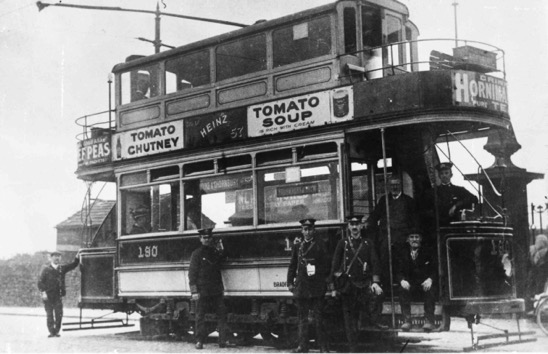
A group of BCT employees pose for the cameraman with top-covered tramcar No 190 — photo undated, but probably taken in the late-Edwardian era given that the armorial device has 'ram and goat' supporters (granted in 1907). Photo courtesy of the National Tramway Museum.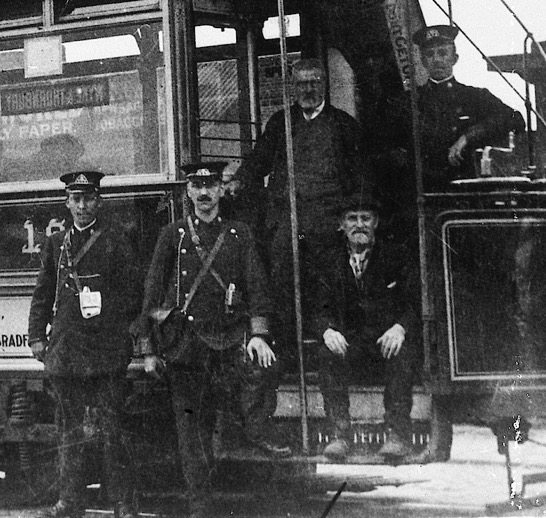
An enlargement of the above photograph showing the two conductors and the motorman (plus interlopers). All three crewmen are wearing the new style cap badges. Photo courtesy of the National Tramway Museum.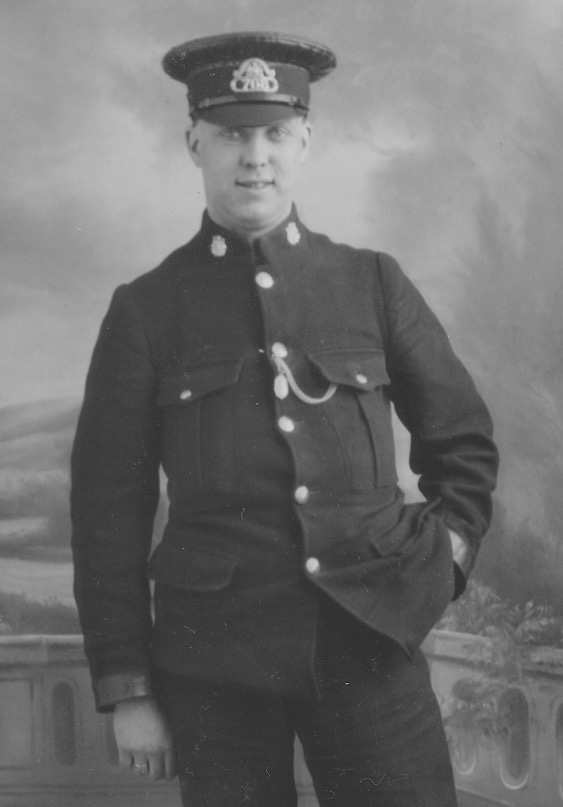
A studio portrait of BCT Employee No 708 in single-breasted jacket — photo undated, but probably taken around the time of the Great War. Author's Collection.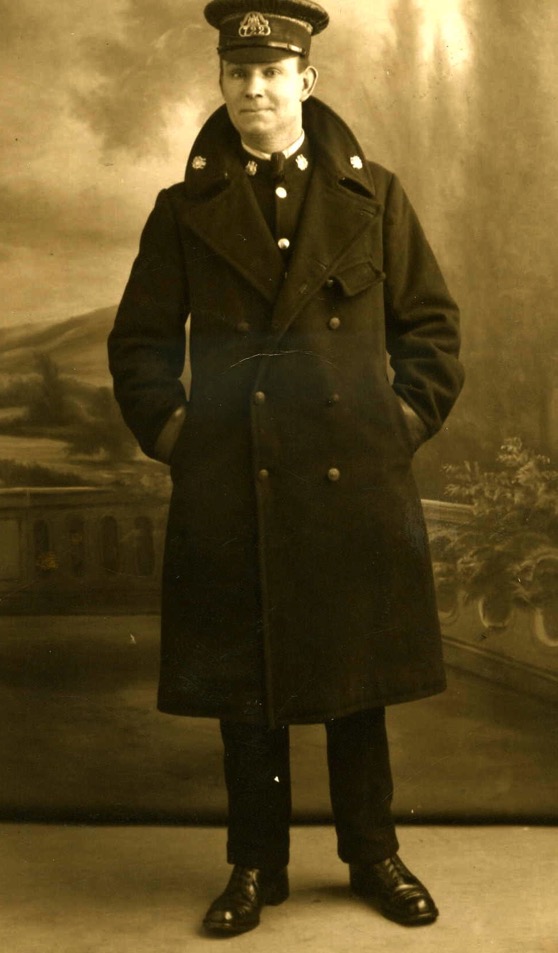
Motorman 722, John Herbert Moss (born 23rd June 1884), probably taken shortly after the Great War or in the early 1920s; he remained a motorman all his career, driving the last tram up Bowling Old Lane and retiring in 1949. He is clearly wearing a single-breasted jacket under his greatcoat. With thanks to his grand-daughter, Mary Twentyman.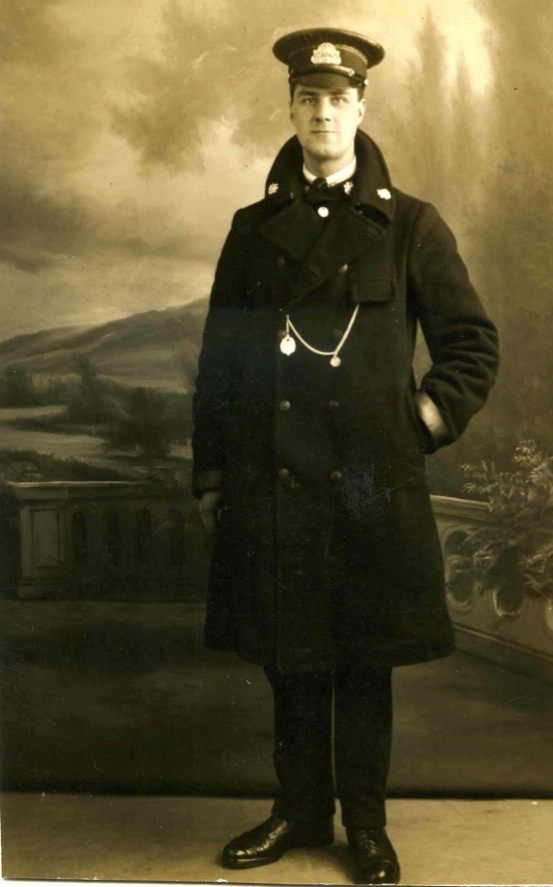
Motorman Norman Clough (Herbert Moss’s brother-in-law), probably taken in the early 1920s, and ostensibly in the same studio as the previous photograph. With thanks to his grand-daughter, Mary Twentyman.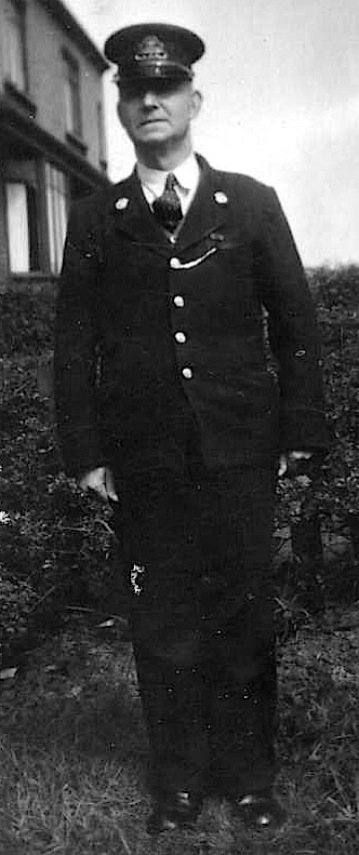
Motorman 722, John Herbert Moss, probably taken shortly before the Second World War. Note the newer style of single-breasted jacket with lapels. With thanks to his grand-daughter, Mary Twentyman.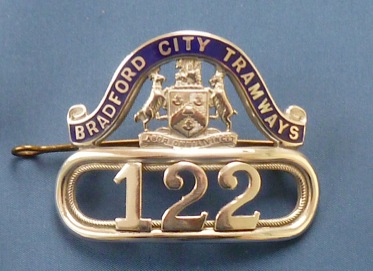
Bradford City Tramways cap badge — circa 1930s/1940s onwards — chrome. Author's Collection.
Collar/lapel badge — chrome (worn from around the 1930s/1940s onwards). Author's Collection.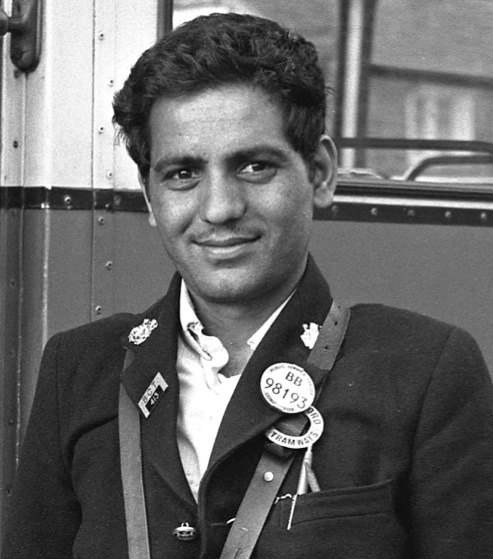
A Bradford City Transport trolleybus conductor — photo taken at Wibsey terminus in May 1971. Although some 20 years after the demise of the tramway, the cash-bag strap still sports a Bradford City Tramways buckle. With thanks to the photographer, David Mitchell.
BCT conductor's cash-bag buckle. Author's Collection.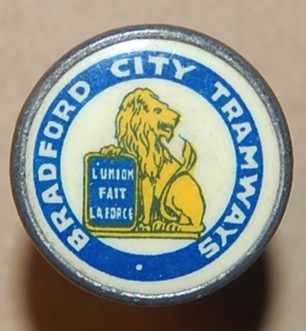
Great War Belgian refugee BCT free travel badge. Photo courtesy of Art Smith.
Senior staff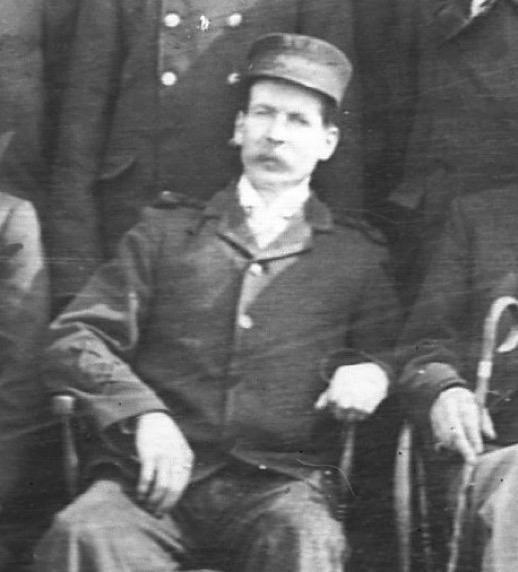
An enlargement of the 1898 depot photograph above showing the solitary inspector. He appears to be wearing a grade badge — 'Inspector ' — though whether embroidered or metal is unclear, along with 'B C T' initials.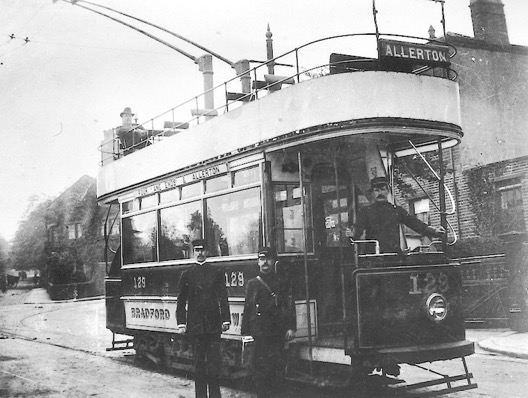
An inspector, a conductor and a motorman pose with Tramcar No 129 at Allerton in August 1902. The men's caps all appear to be devoid of cap badges. Photo courtesy of the National Tramway Museum.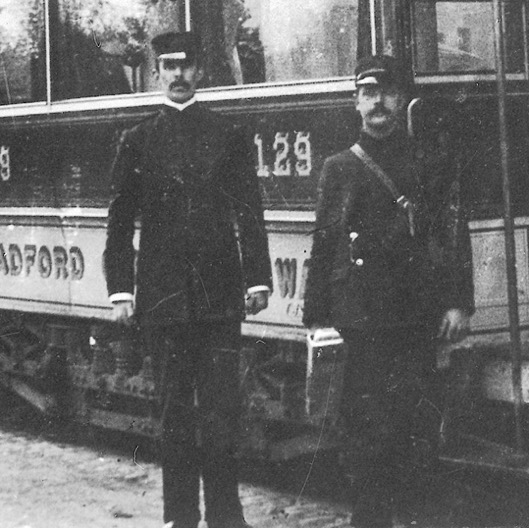
An enlargement of the above photograph showing the inspector, who appears to be wearing a more traditional style of inspector's uniform with stand-up collars.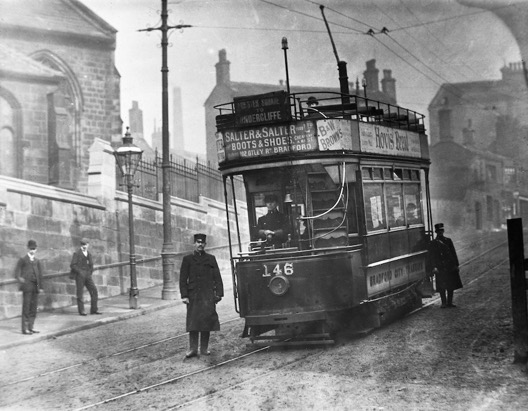
Tramcar No 146 captured on Church Bank in 1903. The shot shows the very steep nature of the Bradford system (here 1 in 9.8) to good effect. Source unknown.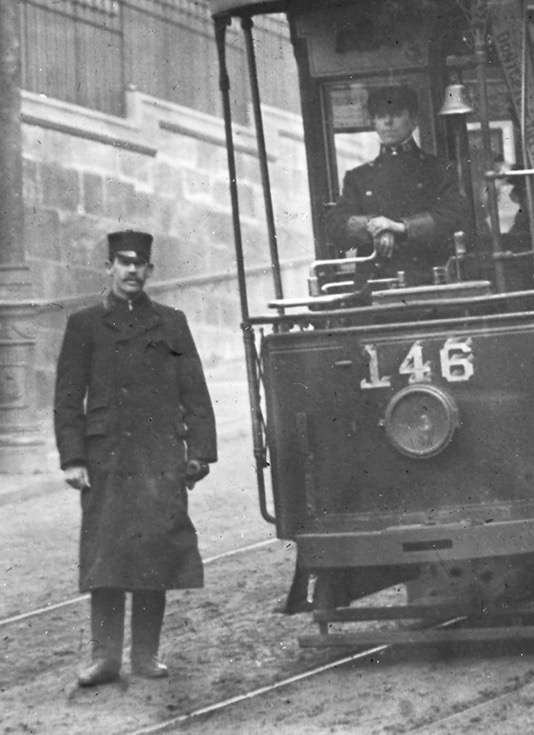
An enlargement of the above photograph showing the motorman (right) and a figure (standing) who is almost certainly an inspector. He is wearing a tall drooping-peak cap modelled on British Military practice, seemingly without a cap badge. His long, double-breasted overcoat appears to carry embroidered collar insignia.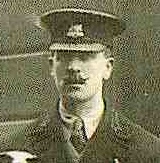
A senior employee, probably an inspector (taken from conductresses photo below) — circa 1916 to 1918. The cap badge differs markedly from those worn by tramcar staff, and is almost certainly the same as that shown below. With thanks to the Graham Hall Archive.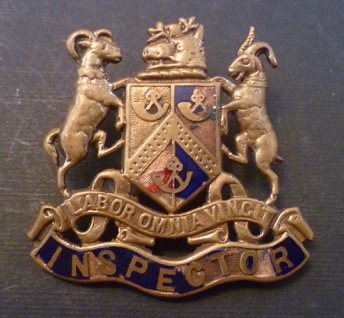
Bradford City Tramways Inspector cap badge — brass with blue and red enamel inlay. This was probably worn from the grant of official arms in 1907 through to closure. Author's Collection.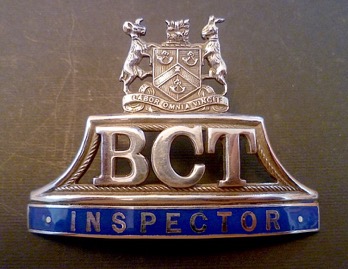
Bradford City Transport inspector's cap badge — chrome with blue inlaid enamel. Bradford City Transport only came into existence in 1952, two years after the demise the tramway, but it is unclear exactly when this style of badge made an appearance. There remains a small possibility that it was worn in the last few years of tramway operation. Author's Collection.
Female staff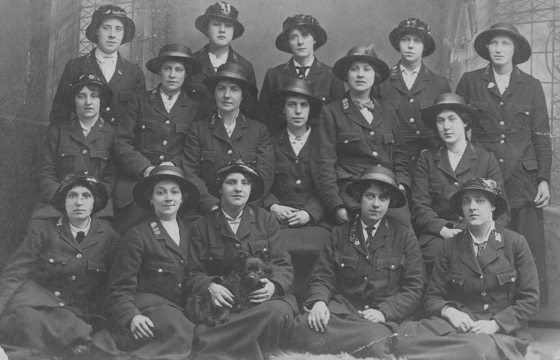
A rare studio shot of a group of Bradford City Tramways Great War conductresses – photo taken in the studios of 'Fred', 7 Horton Lane, Bradford.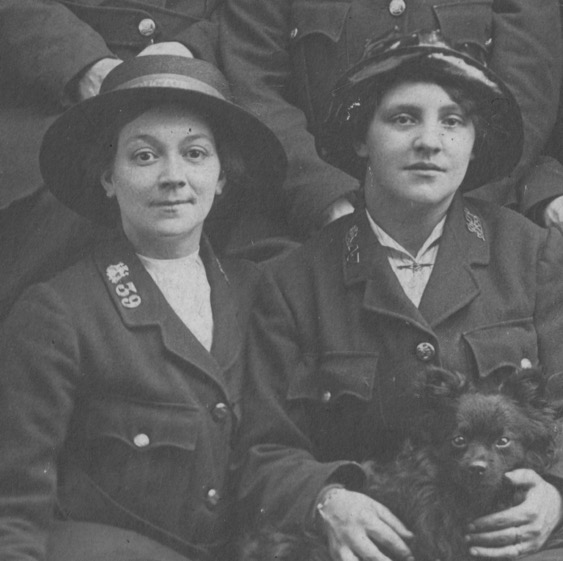
An enlargement of the above photograph showing two of the conductresses. The lady on the left (Employee No 39) is wearing a felt bonnet with a hat band, whilst the lady on the right is wearing a waterproof bonnet.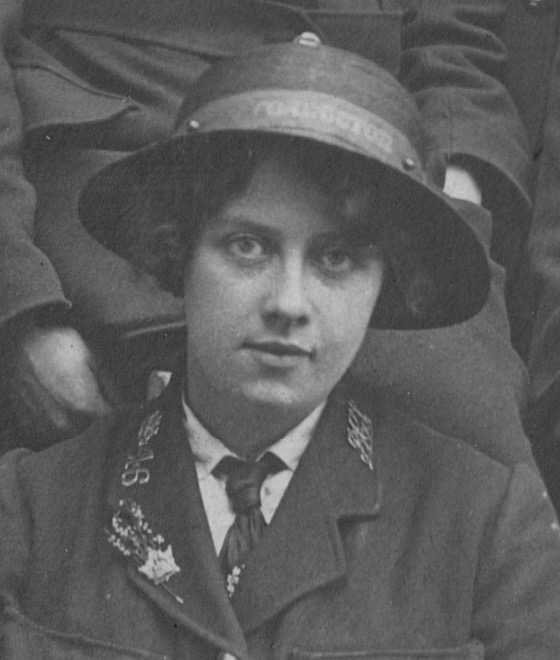
Another enlargement of the above photograph, this time showing Employee No 46. Her right-hand collar bears a municipal-device badge and her employee number, whilst her left-hand collar bears what would appear to be a metal 'BCT' scroll badge. Her hat band bears her grade, 'CONDUCTOR'.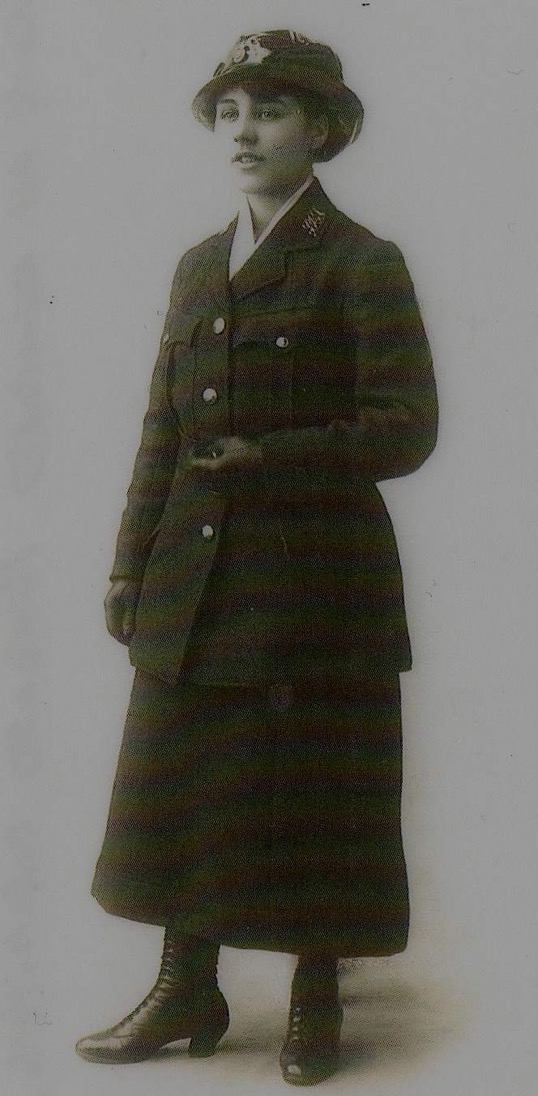
A Bradford City Tramways conductress — photo undated, but almost certainly taken during the Great War. With thanks to the Graham Hall Archive.![]()
Bradford City Tramways conductresses — photo circa 1916 — outside the Bradford City Transport Department Central Office in Bolton Road. The solitary male is more than likely an inspector or the chief inspector. With thanks to the Graham Hall Archive.